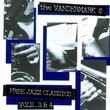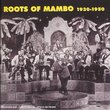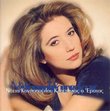| All Artists: Franz Joseph Haydn, Andreas Spering, Capella Augustina, Sunhae Im, Jan Kobow Title: Haydn: Die Schöpfung [SACD Hybrid] Members Wishing: 0 Total Copies: 0 Label: Naxos Release Date: 4/19/2005 Album Type: Hybrid SACD - DSD Genre: Classical Styles: Opera & Classical Vocal, Historical Periods, Classical (c.1770-1830) Number of Discs: 2 SwapaCD Credits: 2 UPC: 747313107360 |
Search - Franz Joseph Haydn, Andreas Spering, Capella Augustina :: Haydn: Die Schöpfung [SACD Hybrid]
![Haydn: Die Schöpfung [SACD Hybrid]](https://nationalbookswap.com/cd//l/89/4689/6124689.jpg) | Franz Joseph Haydn, Andreas Spering, Capella Augustina Haydn: Die Schöpfung [SACD Hybrid] Genre: Classical |
Larger Image |
CD DetailsSimilar CDs
|
CD ReviewsHaydn's Schopfung: Wide Awake Music-Making, Incisively Playe Dan Fee | Berkeley, CA USA | 02/09/2006 (5 out of 5 stars) "Don't hesitate, this SACD multichannel recording is a keeper. Go ahead. Just put the familiar disc in the player. You will soon be feeling like you walk amid the freshest, evergreen-scented woods, saturated in bright early morning light as if you had simply sprung newly whole into sudden being on the very first, pristine original day of creation. No doubt, this effect is exactly what Papa Haydn had in mind, apt to the mythic subject matter at hand, as he composed it. The forces applied here are not gargantuan, but the musical effect is all out of proportion to their accounting. Consider the orchestra, at 12 violins, 4 violas, 4 cellos, 2 double basses, and 1-2 in the other woodwind and brass, except for 3 trombones. A small chamber orchestra, yes, but playing with great ebullience, gifted with high technical command of their period instruments, and involved so totally - identified so totally - with their musical call that they seem to have become one with all the roles they play in this oratorio.
Expertly led by Andreas Spering (who himself was keyboardist for none other than Musica Antiqua Koln), this band simply stands tall as a vivid, full partner with the soloists and the chorus. Their Haydnesque picture-painting is charming, yet ever wise and ever delighted to be part of a whole whose rainbow colors allow nuance as well as a true, saturated tonal palette. Their sheer genius reaches for alchemical mystery. Some of this genius is due to the highly apt tempos that Spering and the band have found. Be warned, the faster sections will catch you up in a whirlwind and put you down again quickly, in new places with new views of the music that came before - and the music that will soon arrive, later. Thus are the inter-related tempos an expression of the larger oratorio structure, as much as Haydn's harmony itself. Like all the best crafts, this is a matter of a sure hand and a full heart, working in cohort with quite a keen mind. The chorus is Vokal Ensemble Koln. Their members aren't listed, but they sound like a smaller chamber choir that is every whit as chock full of vitamins as the Capella Augustina. Their vocal tone is solid at all levels of volume. Their vocal technique never falters. These singers obviously relish the musical challenges of painting the Creation scene as much as the band does. This choir excels at praising God according to Haydn, and given their repeating role as angels striking harps in glory of the Creator, the thrill of celebration is never far off from their massed presence. One immediately grasps the mystical fact that angels need never sleep, nor indeed falter or grow weary or lapse. Thanks to a knowing base of early music practices, the phrasing and the choral textures are a fulsome match for what the instrumentalists are doing. This raises a strange question in the listener's mind: Are the choir's gentlemen achieving the heft and tonal glow that one usually associates with good brass playing? Or, are the brass achieving a sense of fill and inflection that one associates with good singing? Whichever way you go with these matters, you will probably be delighted to welcome this chorus into your listening space, singing this wonderful music. What next? Oh yes, we have three soloists. Starting with the bass-baritone who opens the oratorio as a witness to Spirit, brooding upon the face of the waters of chaos, we are off to a very good start, indeed. Hanno Muller-Brachmann has a solid, flexible tone that can cover a wide tessitura, or vocalized range of high to low notes. At the top notes, he's there; at the bottom notes, he's there. The magic of his singing is rooted in the great heritage of lieder gesang. It is little surprise to read in the liner notes that he took a master class or two with the renowned Dietrich Fischer-Dieskau. Hanno must have been paying attention to his lessons. He articulates and phrases the colorful vocabularies of this text without distracting from the musical flow. Words and music are one, and this surprise easily gets a listener wondering just how much oratorio is like a chamber music form of lieder or song, instead of being a chorus with soloists that has been married to a symphony orchestra. The huge danger in this sort of art is that it can cross over the line to being too cute, too precious, too artificial ... like bad theatrical declamation that has grown entirely too arch. Hanno never goes there, to his credit. Bravo, then. Jan Kobow is the tenor soloist. His singing is impeccable. He, too, has a solid, beautiful voice in all ranges. His way with words again suggests the great lieder singers of the past. On record, to find comparisons equal to his textual involvement, we shall have to listen to great tenors like Peter Pears, Fritz Wunderlich, or Peter Schreier. Jan Kobow is that good, in his own way. Like the bass-baritone, this tenor has a compelling mastery of parlando singing .... phrasing as natural as speech. Words and music can both narrate, and Jan Kobow lets them do so here, in one integrated musical act. This is hardly as spontaneous and easy as his casting of vocal spells suggests, but his art and skill remain nevertheless magical and spell-binding. Finally we come to the soprano, Sunhae Im. She is Korean and won the Korean lieder singing competition held by the Korean Schubert Society. So far as her roots in lieder, then, she is a fitting trio companion. She has a small voice ...(think Jenny Lind or Amelita Galli-Curci, instead of Birgit Nilsson or Jane Eaglen) ...with rather more bell clarity than operatic drama. Like her solo companions, she can caress and inflect a phrase, while keeping the musical line intact. She, too, comprehends parlando style ... and can sing in not only words, but also in phrases and sentences, and even in paragraphs ... however Haydn's narrative demands. Fortunately, her top notes are not the least bit small or tentative. She rises to each clarion occasion, even when the full band and chorus are going full tilt with her. For her duet with Hanno Muller-Brachmann in part three, she is transformed from being an angel into being Haydn's Eve. She warms and glows to the music, making you really believe all over again in that hackneyed dove's-life of lovely human pair-bonding. She is ever a musical partner, not that sort of prima donna whose olympian fire is competitive. She adds, not detracts. If each soloist is very good, alone, they become very special when they sing together. Haydn was fond of setting various trios, rising out of his choruses in this oratorio, so these three are gifted with very, very good vocal opportunities. They blend, almost as if they could become one vocal Trinity superb. This cannot be actually as easy to do as it is easy to hear. Yet, in passing, and when needed, they still remember how to stand out and make their fluent points without imbalancing the trio or flashing into more spotlight than the music commands. My shelf favorite for this work has long been home to the superb recording led by Franz Bruggen on Phillips. Now that performance of great merit and imagination has good company. Highly recommended (for musical as well as for high resolution sound). Excellently sung and played." |



